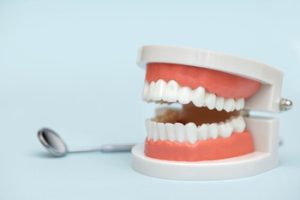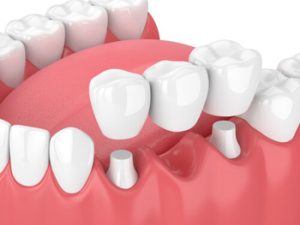It’s surprising how much confidence a lost tooth can take with it. Dental bridges offer a reliable, natural-looking solution to fill that gap. But did you know there are several types of dental bridges? Each one is designed for different dental needs, depending on where the missing teeth are, how many you’ve lost, and the condition of the surrounding teeth. In this blog, we’ll discuss the most common dental bridge types, explain how they work, and help you determine which is best for your smile and lifestyle.
What Are Dental Bridges?
A dental bridge is a permanent solution used to replace one or more missing teeth. It includes an artificial tooth called a pontic, which is held in place by abutment teeth, typically the surrounding natural teeth or dental implants on either side of the gap.
Whether you’ve lost one front tooth or several in a row, dental bridges help restore function, enhance your appearance, and keep your remaining teeth properly aligned.
Why Consider a Dental Bridge? It’s More Than Just Filling a Gap
Here’s why many people choose a dental bridge to replace missing teeth:
1. Restore Your Smile and Confidence
A dental bridge fills the gap a lost tooth leaves, helping you smile again without hesitation. Whether you’re chatting with friends or attending a meeting, you’ll feel more confident knowing your teeth look complete and natural.
2. Chew and Speak With Ease
Missing teeth make it hard to pronounce words clearly or chew properly. A dental bridge helps restore normal function, allowing you to enjoy your meals and conversations without discomfort or awkwardness.
3. Prevent Shifting of Surrounding Teeth
When there’s an empty space, adjacent teeth tend to drift into it. This movement can lead to bite problems, crooked teeth, and even jaw pain. A dental bridge keeps your remaining teeth in place and maintains a balanced bite.
4. Protect Your Oral Health
Spaces between teeth can trap plaque and bacteria, which may result in tooth decay and gum disease. By filling the space with a false tooth, bridges reduce these risks and support better long-term dental health.
5. Support Facial Structure
Teeth support the shape of your face. Without them, you may notice sagging or a sunken appearance. Dental bridges help maintain your facial contours, giving your features the support they need.
6. Cost-Effective Tooth Replacement
Compared to some other dental prosthetics, bridges, especially traditional ones, are often more affordable while offering durable, natural-looking results.
In short, a dental bridge does more than restore appearance. It helps preserve the health, function, and integrity of your entire mouth.
The Main Types of Dental Bridges
Not all dental bridges are created equal. Let’s explore the most common types of dental bridges, each with its own distinct benefits and ideal use cases.
1. Traditional Dental Bridges: The Classic Choice
Traditional bridges are the most widely chosen option for dental bridges. This option involves placing dental crowns on two healthy natural abutment teeth on either side of the gap, with a pontic tooth in between.
Best suited for:
People with healthy natural teeth on both sides of a missing tooth or multiple teeth.
Pros:
- Strong and durable
- Mimics natural tooth function well
- Ideal for back teeth or front tooth replacement
Considerations:
- Requires reshaping of the adjacent teeth
- Not suitable if supporting teeth are weak or compromised
Most dental bridges used in general practice fall into this category due to their longevity and strength.
2. Implant-Supported Dental Bridges: The Modern Marvel
Implant-supported bridges are secured by dental implants rather than relying on natural teeth for support. Each artificial tooth may be supported by its implant, or the bridge can be anchored to implants at each end.
Best suited for:
Patients missing three or four teeth in a row, or those with remaining teeth that aren’t strong enough to serve as abutments.
Pros:
- The strongest and most stable option
- Doesn’t rely on or damage adjacent natural teeth
- It helps preserve the underlying gum tissue and jawbone
Considerations:
- Requires surgery
- Longer healing time
- Higher initial cost
An implant supported dental bridge is considered the gold standard in dental prosthetics when it comes to replacing multiple missing teeth.
Choosing the Right Dental Bridge for You
Choosing the right dental bridge depends on your individual needs. Your dentist will take various factors into account, including:
- The number of missing teeth
- The condition of surrounding teeth
- The location of the gap
- Your gum health
- Your budget and preferences
For instance, a traditional bridge might be suitable if you still have healthy teeth nearby, while implant supported bridges are ideal for long term tooth restoration without impacting existing teeth.
The Dental Bridge Procedure: What to Expect
The dental bridge procedure typically involves two or more appointments, depending on the type of bridge.
- Initial Consultation: Your dentist assesses your oral health and discusses the most suitable type of bridge.
- Tooth Preparation: For traditional bridges, the supporting teeth are reshaped to accommodate dental crowns.
- Impressions: Impressions of your teeth are taken and delivered to a dental lab to craft your customised bridge.
- Temporary Bridge: A temporary bridge is usually fitted to protect your teeth while your permanent one is being made. However, if your clinic uses CEREC technology, you might not need one; same day bridges can be designed and fitted for just one visit.
- Bridge Placement: Your new dental bridge is fitted and adjusted to ensure comfort, alignment, and bite.
- Follow Up: Your dentist will check the fit and ensure you’re comfortable with your dental restoration.
Taking Care of Your Dental Bridge
Proper care is essential to extend the life of your dental bridge and maintain your dental health. Here are some essentials:
- Brush at least twice daily with a soft-bristle brush.
- Floss around the bridge and under the pontic teeth using a floss threader
- Use an antibacterial mouthwash.
- Maintain good oral hygiene habits.
- Schedule routine dental visits for professional cleanings and exams.
A well-maintained bridge can last 10 years or more. Investing in proper dental bridge care is just as important as choosing the right type.
Can You Replace a Dental Bridge?
Yes. Over time, a bridge may wear out, or the supporting teeth may change. Your dentist can assess whether it’s time for a new dental bridge or if another form of dental restoration would be more suitable.
When Might a Dental Bridge Not Be Recommended?
While bridges are a great solution for many, there are cases where they may not be ideal:
- If you have extensive gum disease or tooth decay
- If your adjacent teeth are not strong enough
- If the gap is too wide for a traditional bridge to span
- If you’re missing all your natural teeth in a row
In such cases, dental implants or full dentures might be explored instead.
Say Hello to Same Day Smiles: The Innovation of CEREC Bridges
Imagine walking into your dental clinic with a missing tooth and walking out with a brand new smile, all on the same day. Thanks to modern dental technology, this is now possible with CEREC bridges.
CEREC (Chairside Economical Restoration of Esthetic Ceramics) is a state of the art system that allows dentists to design, fabricate, and place dental restorations like crowns and bridges in just one appointment. Unlike traditional bridges that require multiple visits and temporary fittings, a CEREC bridge offers a faster, more convenient alternative.
What Makes CEREC Bridges Different?
- Speed: Traditional dental bridges often involve waiting days or even weeks for lab work. CEREC bridges are made on site, often within hours.
- Precision: Digital impressions are taken using a 3D scanner, eliminating the need for messy impression materials and increasing accuracy.
- Custom Design: The software designs a bridge that perfectly fits your bite and matches your surrounding teeth in shape and colour.
- No Temporary Bridge Needed: Since the final bridge is created and placed on the same day, there’s usually no need for a temporary solution.
When Are CEREC Bridges an Option?
CEREC bridges are typically best suited for patients needing single tooth replacement or smaller bridges, particularly where adjacent teeth are strong and healthy enough to serve as abutment teeth.
While not always ideal for complex cases or implant supported restorations, they are a fantastic solution for many looking for quick, aesthetic tooth restoration.
Fast, Functional, and Natural Looking
CEREC bridges combine digital dentistry and modern materials to produce beautiful, long-lasting results in a fraction of the time. If you value convenience and cutting-edge care, it’s worth asking your dentist whether a CEREC bridge is right for you.
Frequently Asked Questions
- Do dental bridges look natural?
Yes. Modern dental prosthetics are designed to blend seamlessly with your existing teeth, especially when made from materials like porcelain fused to metal.
- Can I eat normally with a dental bridge?
Yes, once your bridge is fully in place, you can eat most foods as usual. It’s best to avoid overly hard or sticky foods that may damage the bridge.
- Will I need a temporary dental bridge?
In most cases, a temporary bridge is placed while your permanent one is being made by a dental lab to protect the prepared teeth and maintain appearance.
- How do I clean around my dental bridge?
Use a soft toothbrush, floss daily with a floss threader or interdental brush, and rinse with an antibacterial mouthwash. Regular dental visits are essential.
- Can a dental bridge be repaired if damaged?
Minor issues may be fixed, but extensive damage usually requires a new dental bridge. It’s best to see your dentist for an assessment as soon as possible.
- What is the cost of different types of dental bridges?
The cost varies depending on the type, materials used, and whether implants are involved. A personalised quote from your dentist will provide the most accurate estimate.
- Is the dental bridge procedure painful?
Most patients experience little to no discomfort during the dental bridge procedure. Local anaesthesia is used, and any post-procedure soreness is usually mild and temporary.
The Bottom Line: Dental Bridges Offer More Than Just a Smile
Your dentist will guide you toward the most appropriate option depending on your individual needs and oral condition. No matter which bridge you choose, maintaining good dental hygiene and proper care will help you get the most out of your investment.
Take the First Step: Restore Your Smile with a Dental Bridge Today
Whether you’ve lost a single front tooth or several molars, dental bridges are a proven way to reclaim your smile and support your overall dental well-being. Learning about the various types of dental bridges brings you closer to making a confident choice that suits your lifestyle and long-term oral health.
If you’re considering a bridge, book an appointment with Available Dental Care at (02) 4062 8763 or (02) 4628 0573 and talk about your options. A beautifully restored smile may be closer than you think.
Note: Any surgical or invasive procedure carries risks. Before proceeding, you should seek a second opinion from an appropriately qualified health practitioner.
References
- Cleveland Clinic. (n.d.). Dental bridges. Retrieved from https://my.clevelandclinic.org/health/treatments/10921-dental-bridges
- Mayo Clinic. (n.d.). Dental implant surgery. Retrieved from https://www.mayoclinic.org/tests-procedures/dental-implant-surgery/about/pac-20384622
- Colgate. (n.d.). What is CEREC in dentistry? Retrieved from https://www.colgate.com/en-us/oral-health/dental-visits/what-is-cerec-in-dentistry#
- Healthline. (n.d.). Best practices for healthy teeth. Retrieved from https://www.healthline.com/health/dental-and-oral-health/best-practices-for-healthy-teeth




